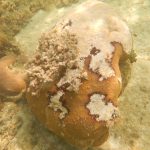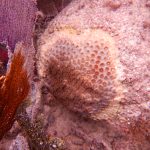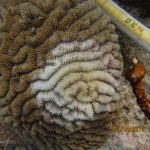Stony Coral Tissue Loss Disease (SCTLD)
What is Stony Coral Tissue Loss Disease?
Stony Coral Tissue Loss Disease (SCTLD) is a coral disease that first was discovered in Virginia Key, Miami in 2014. It since has spread to and harmed 22 different species of coral and is present in 22 different Caribbean countries, including Florida, the U.S. Virgin Islands, and Puerto Rico. It is suspected to be a bacterial pathogen spreading through waterways, but the true cause of the disease is still unknown. This disease spreads quickly and kills corals rapidly, making it a great threat if it were to reach the Hawaiian Islands. Once infected, corals typically die in weeks to months. It is likely the most deadly coral disease outbreak in history, due to it’s unprecedent scale, rate of spread. and high mortality rate.
- Regulatory Status: A rule regarding SCTLD is in the process of being developed.
- What You Can Do: Report any abnormal or diseased looking corals you see while diving, snorkeling etc.
- Distribution: Not currently present in Hawaiʻi.

SCTLD in Montastraea cavernosa.
Photo credit above: Wikimedia: Fractal24
- Photo taken in the Upper Keys – SCTLD and Black Band Disease on Siderastrea siderea.
- Photo taken in Upper Keys – SCTLD on Montastrea cavernosa.
- SCTLD on Meandrina meandrites, maze coral.
Photo credit above: FWC Fish and Wildlife Research Institute
DESCRIPTION:
- The main characteristic of this disease are multiple rapidly growing lesions on the surface of the coral. Sometimes this presents itself as a series of blotches that spread out and eventually connect with each other. This disease can sometimes be difficult to identify due to its similarities to other coral diseases.
- Corals infected typically die in weeks to months, though some corals may live a year or two after being infected.
- Some species or corals are not affected by this disease.
- There is risk of this disease reaching Hawaiʻi from vessels in the Caribbean, specifically from ballast water and biofouling. There is ongoing legislation being developed to prevent this issue.
IMPACTS:
- “ Nearly 90% of Florida’s Coral Reef has been affected – over 109,700 acres. ” (Florida Fish and Wildlife Conservation Commission)
- There is huge potential for negative economic and cultural impact in the Caribbean. The Caribbean depends on coral reefs for coastal protection, tourism, fishing and seafood, biomedical research, as well as cultural and aesthetic values.
- “A study by The Nature Conservancy found that reef-associated tourism generates over $7.9 billion for Caribbean economies annually.” (UNEP)
- 22 different species of coral are affected by the disease, which creates the potential for massive ecological damage with disease spread.
- It is regarded as the deadliest coral disease ever recorded.
ERADICATION & CONTROL METHODS:
- “In an effort to reduce the spread of disease and loss of live coral tissue, several laboratory and field trials have been done including topical applications of chlorine and amoxicillin, topical chlorinated epoxy, amputation of affected regions of diseased corals, and relocation of healthy regions of diseased corals.” (AGGRA)
- “Even the most effective treatments are acting only at the lesion level. New lesions continue to erupt and overtake treatments, leading to ongoing tissue loss as well as necessary frequent re-visitation to apply additional treatments. All corals needed more than one treatment.” (AGGRA)
- “Application of antibiotic paste to affected corals has shown to be successful in stopping or slowing the progression of SCTLD lesions.” (NOAA)
- Thousands of coral are being collected and brought to aquariums for their safety until the disease subsides.
- “To mitigate SCTLD from entering Hawaii, DAR proposes that vessels that have been to a disease-infected area within the last five ports should not discharge ballast water in state waters.” (Spectrum News)
WHAT YOU CAN DO:
- Never introduce new corals, organisms or fish to ocean habitat. Rehome aquariums and don’t let it loose.
- Wear reef safe sunscreen or UV protectant swimwear in the ocean to protect corals against effects of harmful chemicals. Weakened corals are more susceptible to disease.
- Learn to identify signs of SCTLD, talk to friends and family about the disease and its effects.
- Report diseased or abnormal looking corals.
- Report Diseased Coral
- New Coral Disease is Quickly Killing Corals in Florida and the Caribbean – (DLNR)
- Officials discuss ways to prevent coral disease from entering Hawaii waters – (Spectrum News)
- Coral Disease Outbreak – (Atlantic and Gulf Rapid Reef Assessment) (Maps of disease spread)
- What is Stony Coral Tissue Loss Disease? – (Florida Fish and Wildlife Conservation Commission)
- Stony Coral Tissue Loss Disease FAQ – (Florida Fish and Wildlife Conservation Commission)
- Stony Coral Tissue Loss Disease – (UN Environment Programme)
- Stony Coral Tissue Loss Disease (SCTLD) -(Coral Disease & Health Consortium)
- Stony Coral Tissue Loss Disease – (NOAA Coral Reef Conservation Program)


